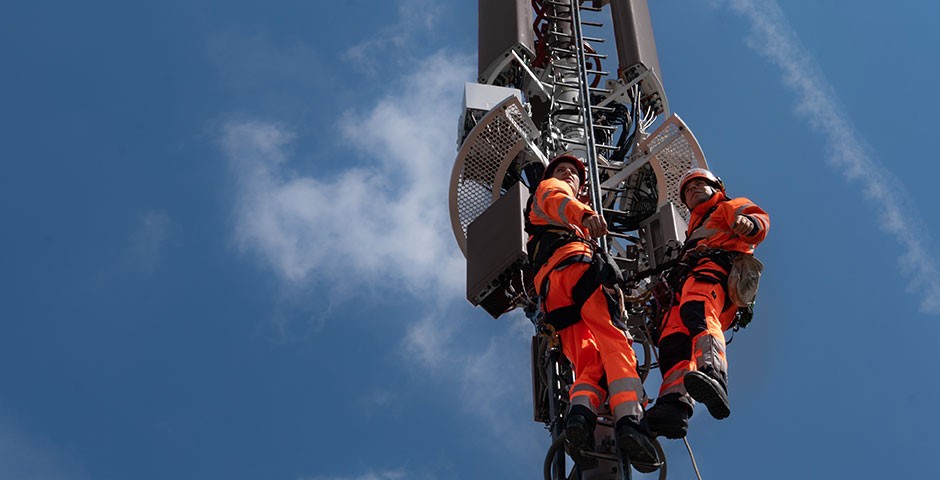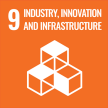
Wireless technology is based on the premise: the higher the frequency, the worse the distribution conditions and the greater the transmission losses. To compensate for this law of physics, adaptive antennas are used for the slightly higher frequencies of 5G (maximum 3.8 GHz) and the immense demands on this new mobile radio standard.
A watering can instead of a sprinkler
These antennas mean the signal can be focused in the direction of the user through beamforming or Massive MIMO. By concentrating the radio signal on a more limited area, interference in the mobile network is also reduced, resulting in less noise and better user signals. This focusing also means that the signals can be transmitted more precisely with less electrical energy. So a conventional mobile phone antenna works like a lawn sprinkler and covers an entire sector while an adaptive antenna is like a watering can that only waters the flowers in the place and quantity required.
The new beamforming technology enables masts to generate lots of small focused electric fields and their strength is matched to the particular user.
How do adaptive antennas work?
Adaptive antennas comprise a host of individually controlled antenna elements – typically 64 or 32 antenna elements, each with its own amplifier, arranged in columns and rows. Targeted electrical adjustments (phase shifting) can change the direction of transmission without physically moving the antenna elements. The more antenna elements are coordinated simultaneously, the better the transmission signal is bundled and the smaller the illumination volume.
«Adaptive antennas and 5G are not just more efficient – they can also transmit data with fewer immissions.»
Dr Hugo Lehmann, Head of Competence Center for Electromagnetic Fields
Significantly better energy efficiency
«Adaptive antennas and 5G are not just more efficient – they can also transmit data with fewer immissions,” explains Dr Hugo Lehmann, Head of Competence Center for Electromagnetic Fields. He is convinced that fewer new facilities would have to be built in Switzerland if adaptive antennas could be used to their full potential. Since each system uses a basic amount of energy, fewer systems also mean lower electricity consumption. In addition, 5G has a higher power-saving potential than 4G due to its streamline signal structure. Using 5G technology instead of LTE for the further expansion of mobile networks can achieve energy savings of between 50% and 70%.
Dr Lehmann also sees the use of adaptive antennas as an important component of a powerful 5G mobile network. He argues that there are clear advantages in terms of flexibility, capacity gain, user-defined and lower exposure alongside reduced power consumption.
Huge potential to reduce exposure
The focused transmission of information to individual users in a radio cell means the signals are only sent where they are needed. This spatial diversity also leads to a lower average exposure over time than with older technologies.
A simulation for the city of Ghent in Belgium shows that a Massive MIMO capable network generates five times less exposure than a 4G network without adaptive antennas for the same usage scenarios. The analysis also shows that that the greater the number of elementary antennas, the lower the exposure. This has not yet been proven in reality because 5G networks are only now emerging, but it shows the potential of the technology in the area of exposure reduction.
Just a fraction of the power in live operation
Model calculations and measurements on individual adaptive antennas show that only a fraction of the theoretical maximum value of the transmission power is emitted when beamforming is used in most cases. Even with good traffic load and different scenarios, no more than a quarter of the theoretical maximum power is transmitted over a measurement period of six minutes The measurement period of six minutes is relevant for compliance with the immission limit values. These simulations have been confirmed by measurements of the average transmission power over six minutes for base stations with adaptive antennas. In summary, this means that the exposure per transmitted information unit with beamforming decreases compared to today's mobile phone networks.
Limit values are still always met
In Switzerland today, adaptive antennas are evaluated in the same way as passive antennas. It is assumed that the total power is emitted in all directions at all times. In reality, however, this is never the case, as the total power of the antenna is shared among the active users: with two simultaneously active users, the transmission power per beam is half the maximum power. If there are four users, a quarter of the maximum power is transmitted in each of the four directions. When there are lots of users spread across an area, the exposure becomes smaller. If, on the other hand, only one user or several users are active in the same direction, the entire service is transmitted in that direction. The bundling of the antennas, however, means this is not sent across the entire coverage area of the antenna. In this case the exposure is focused in the direction of the users, but low in the rest of the radio sector. There is often a specific fear within the population that the exposure from adaptive antennas in the beam will be excessive. People forget, however, that even in these beams the relevant limit values must always be observed.
Latest news about Swisscom
Subscribe to News
Contact us
Address
Swisscom
Media Relations
Alte Tiefenaustrasse 6
3048 Worblaufen
Postal address:
Postfach, CH-3050 Bern
Switzerland
Contact
Tel. +41 58 221 98 04
media@swisscom.com
Other contacts
Contributing to sustainability
Adaptive antennas make a direct contribution to the following United Nation goals for sustainable development:

A mobile phone network with adaptive antennas generates up to five times less immissions, making an active contribution to a healthy life and well-being.

The expansion of the mobile communications infrastructure with the latest technology promotes broad-based and sustainable industrialisation and supports innovation.

5G uses 40-70% less energy than 4G, thus helping to combat climate change.
